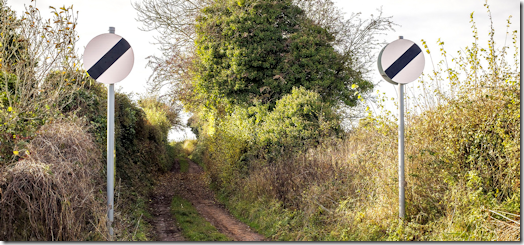 On lessons, it is quite common for pupils to query why there is a national speed limit in force in places where it is obviously not possible or safe to drive above about 30-40mph. One particular road around here is a single track with crude passing places on it (not the one shown in the photo above, but similar).
On lessons, it is quite common for pupils to query why there is a national speed limit in force in places where it is obviously not possible or safe to drive above about 30-40mph. One particular road around here is a single track with crude passing places on it (not the one shown in the photo above, but similar).
The history of the national speed limit (NSL) is quite interesting.
The first speed limits were introduced as long ago as 1865 for vehicles which were not powered by animals. A limit of 2mph in urban areas, and 4mph everywhere else, was in force, and someone with a red flag had to walk in front of the vehicle. The first speeding ticket was issued in 1896, when someone was assessed to be driving at 8mph in a residential area.
Obviously, the maximum speed capability of vehicles improved, and people were flouting the Law on a regular basis. So in 1903 the maximum speed limit was increased to 30mph.
By 1930, that speed limit was being ignored, too, and the Road Traffic Act got rid of speed limits completely. Of course, at that time, not many cars could go much above that anyway, so it wasn’t a problem for a while. However, the number of road deaths began to increase and in 1935 a 30mph limit was introduced in built-up areas, and that remains the case up to the present day. However, there were no limits anywhere else.
The first motorway appeared in 1958. Most cars could only manage up to about 50mph, so having no speed limit wasn’t much of a problem. But in 1964 – with motorways being the straightest and flattest roads available, and still unrestricted – the rally driver, Jack Sears, took a test car (a Cobra Coupe) on the M1 and got up to 185mph. The newspapers were all over it, citing it as dangerous driving, and debate still rages over whether he was to blame for the trial the following year of a 70mph limit on motorways, though the foggy winter and number of accidents it led to was probably a factor. In 1967, the 70mph limit became Law. It applied to all non-urban roads.
In 1973 there was a major oil crisis. To conserve fuel, the NSL was temporarily dropped to 50mph. This was lifted in early 1974. However, later that year, as part of a fuel conservation initiative, the NSL on non-motorway roads was reduced to 50mph. But in 1977, this was relaxed and the NSL on those roads went up to 60mph. The two NSLs were made permanent in 1978.
And that’s why we have the speed limits we have today.